 The Loss of the Romney Man of War, by Richard Corbould
| |
| History | |
|---|---|
| Name | Romney |
| Ordered | 20 July 1759 |
| Builder | Woolwich Dockyard |
| Laid down | 1 October 1759 |
| Launched | 8 July 1762 |
| Completed | By 4 September 1762 |
| Honours and awards |
|
| Fate | Lost on 19 November 1804 |
| General characteristics | |
| Class and type | 50-gun fourth rate |
| Tons burthen | 1,02834⁄94 bm |
| Length |
|
| Beam | 40 ft (12.2 m) |
| Depth of hold | 17 ft 2 in (5.2 m) |
| Propulsion | Sails |
| Sail plan | Full-rigged ship |
| Complement | 350 |
| Armament | |
HMS Romney was a 50-gun fourth rate of the Royal Navy. She served during the American War of Independence, and the French Revolutionary and Napoleonic Wars in a career that spanned forty years. Five ships of the Royal Navy have been named HMS Romney. The origins of the name are from the town of New Romney, although it may be that the name entered the Royal Navy in honour of Henry Sydney, 1st Earl of Romney.
Launched in 1762, Romney spent most of her early career in North American waters, serving on the Newfoundland station, often as the flagship of the commander-in-chief. The ship was involved in the tensions leading up to the American Revolution when she was sent to support the Boston commissioners enforcing the Townshend Acts in 1768. Her actions involved impressing local sailors, confiscating a vessel belonging to John Hancock and providing a refuge for the unpopular commissioners when rioting broke out. She remained in American waters for part of the ensuing war, but towards the end operated in European waters after the French entry to the conflict.
Romney was laid up in ordinary or under repair for most of the subsequent years of peace, but returned to active service on the outbreak of war with Revolutionary France. She was in the Mediterranean supporting Lord Hood's occupation of Toulon in 1793, and remained there for several years. During this time she captured the 44-gun French Sibylle. Romney briefly returned to North America and then served in the Red Sea. Assigned to blockade the Dutch coast, Romney ran aground in November 1804 while sailing to join the fleet off Den Helder. She broke up after attempts to float her off failed.
- ^ "No. 20939". The London Gazette. 26 January 1849. p. 237.
- ^ "No. 21077". The London Gazette. 15 March 1850. pp. 791–792.